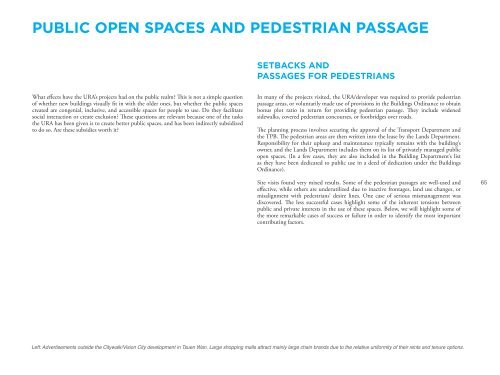Treating the Symptoms - A Critical Review of ... - Civic Exchange
Treating the Symptoms - A Critical Review of ... - Civic Exchange
Treating the Symptoms - A Critical Review of ... - Civic Exchange
- No tags were found...
You also want an ePaper? Increase the reach of your titles
YUMPU automatically turns print PDFs into web optimized ePapers that Google loves.
Public Open Spaces and Pedestrian PassageSetbacks andPassages for PedestriansWhat effects have <strong>the</strong> URA’s projects had on <strong>the</strong> public realm? This is not a simple question<strong>of</strong> whe<strong>the</strong>r new buildings visually fit in with <strong>the</strong> older ones, but whe<strong>the</strong>r <strong>the</strong> public spacescreated are congenial, inclusive, and accessible spaces for people to use. Do <strong>the</strong>y facilitatesocial interaction or create exclusion? These questions are relevant because one <strong>of</strong> <strong>the</strong> tasks<strong>the</strong> URA has been given is to create better public spaces, and has been indirectly subsidizedto do so. Are <strong>the</strong>se subsidies worth it?In many <strong>of</strong> <strong>the</strong> projects visited, <strong>the</strong> URA/developer was required to provide pedestrianpassage areas, or voluntarily made use <strong>of</strong> provisions in <strong>the</strong> Buildings Ordinance to obtainbonus plot ratio in return for providing pedestrian passage. They include widenedsidewalks, covered pedestrian concourses, or footbridges over roads.The planning process involves securing <strong>the</strong> approval <strong>of</strong> <strong>the</strong> Transport Department and<strong>the</strong> TPB. The pedestrian areas are <strong>the</strong>n written into <strong>the</strong> lease by <strong>the</strong> Lands Department.Responsibility for <strong>the</strong>ir upkeep and maintenance typically remains with <strong>the</strong> building’sowner, and <strong>the</strong> Lands Department includes <strong>the</strong>m on its list <strong>of</strong> privately managed publicopen spaces. (In a few cases, <strong>the</strong>y are also included in <strong>the</strong> Building Department’s listas <strong>the</strong>y have been dedicated to public use in a deed <strong>of</strong> dedication under <strong>the</strong> BuildingsOrdinance).Site visits found very mixed results. Some <strong>of</strong> <strong>the</strong> pedestrian passages are well-used andeffective, while o<strong>the</strong>rs are underutilized due to inactive frontages, land use changes, ormisalignment with pedestrians’ desire lines. One case <strong>of</strong> serious mismanagement wasdiscovered. The less successful cases highlight some <strong>of</strong> <strong>the</strong> inherent tensions betweenpublic and private interests in <strong>the</strong> use <strong>of</strong> <strong>the</strong>se spaces. Below, we will highlight some <strong>of</strong><strong>the</strong> more remarkable cases <strong>of</strong> success or failure in order to identify <strong>the</strong> most importantcontributing factors.65Left: Advertisements outside <strong>the</strong> Citywalk/Vision City development in Tsuen Wan. Large shopping malls attract mainly large chain brands due to <strong>the</strong> relative uniformity <strong>of</strong> <strong>the</strong>ir rents and tenure options.
















